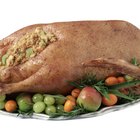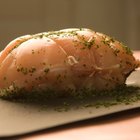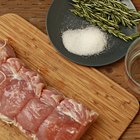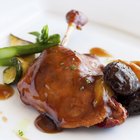ALLEKO/iStock/GettyImages
Despite popularity in many parts of the world, goose isn't a common entree in America. Geese are notoriously fatty, but their rendered fat is a secret ingredient in some of the richest, most indulgent recipes around. The meat itself -- all of which is dark meat -- is relatively lean, but the older the goose is, the tougher the meat. Opt for smaller, younger birds if possible. Brine your goose before roasting to impart moisture and flavor into the meat and to protect it against drying out during cooking.
Make room in the fridge for a bucket pot you can soak the goose in. You need something large enough to completely immerse the entire bird in. Wash out the bucket with warm water and dish soap and rinse thoroughly.
Fill the bucket about two-thirds as much as you need to submerge the goose. Fill the remaining third with another liquid that imparts a desirable flavor into the goose. You could use apple juice or cider, for example, or another fruit juice like pineapple or cranberry. Beer, wine and tea also work, as do various types of vinegar. However, you can use water alone if you prefer.
Dump roughly 1 cup of kosher salt per gallon of liquid into the bucket. If you want to use table salt, it must not be fortified with iodine. Also, because it weighs more by volume than kosher salt, use less; stick to about 3/4 cup per gallon of liquid. The precise salt quantity isn't important, though less than this formula is ineffective; keep in mind, though, that the more you add to the brine the saltier the goose ends up.
Sweeten the brine with sugar, honey, brown sugar, molasses or maple syrup. Choose one that complements the goose recipe and the flavored brining liquid you use. While a sweetener isn't necessary for the brine to work from a chemical standpoint, it adds depth of flavor and helps counteract some of the saltiness the brine imparts. Add about 1/2 cup per gallon of liquid.
Season the brine with dried or fresh herbs and spices that either appear in the goose recipe you're following or that go well with the other flavors you incorporate. Like the sweetner, this is optional, but it imparts more taste into the goose. Since you'll be soaking the bird for some time, let the brine work for you as much as possible.
Stir the brine with a wooden or other large cooking spoon. Fully dissolve the salt and sweetener and distribute the seasonings.
Place the entire goose into the brine. Confirm that it's completely covered; add a little more water or your flavored brining liquid as needed if it's not quite fully submerged. Refrigerate the brining goose for 12 to 24 hours for the best results. Less time is less effective, but more time risks over-salting the meat and turning it a bit mushy.
Related Articles
How to Brine a Pheasant

How to Brine a Turkey Using Orange Juice

How to Make a Good Brine for Pork

How to Brine a Boston Butt
How to Make a Brine for Quail

How to Bake Goose Breasts

Brine for a Deer Ham

How to Brine Pork Loins

How to Make a Marinade for a Whole Pig

How to Brine Pork Leg

How to Brine Pork Roast

How to Cook Skinned Wild Goose

How to Brine a Duck Leg

Brine Solution for Beef Brisket

How to Slow Cook an Eye of Round Roast ...

Do You Have to Cook the Chicken After ...

Cola for a Ham Brine

How to Brine a Butterball Turkey

How to Make Salt Brine

Can You Slow Cook Just a Pork Loin or ...
References
Tips
- When filling the bucket, remember to account for displacement of the brining liquid when the goose goes in to avoid overflow.
Writer Bio
Eric Mohrman is a food and drink, travel, and lifestyle writer living in Orlando, Florida. He has professional experience to complement his love of cooking and eating, having worked for 10 years both front- and back-of-house in casual and fine dining restaurants. He has written print and web pieces on food and drink topics for Visit Florida, Orlando Style Magazine, CrushBrew Magazine, Agent Magazine, Dollar Stretcher Magazine, The 863 Magazine and other publications.